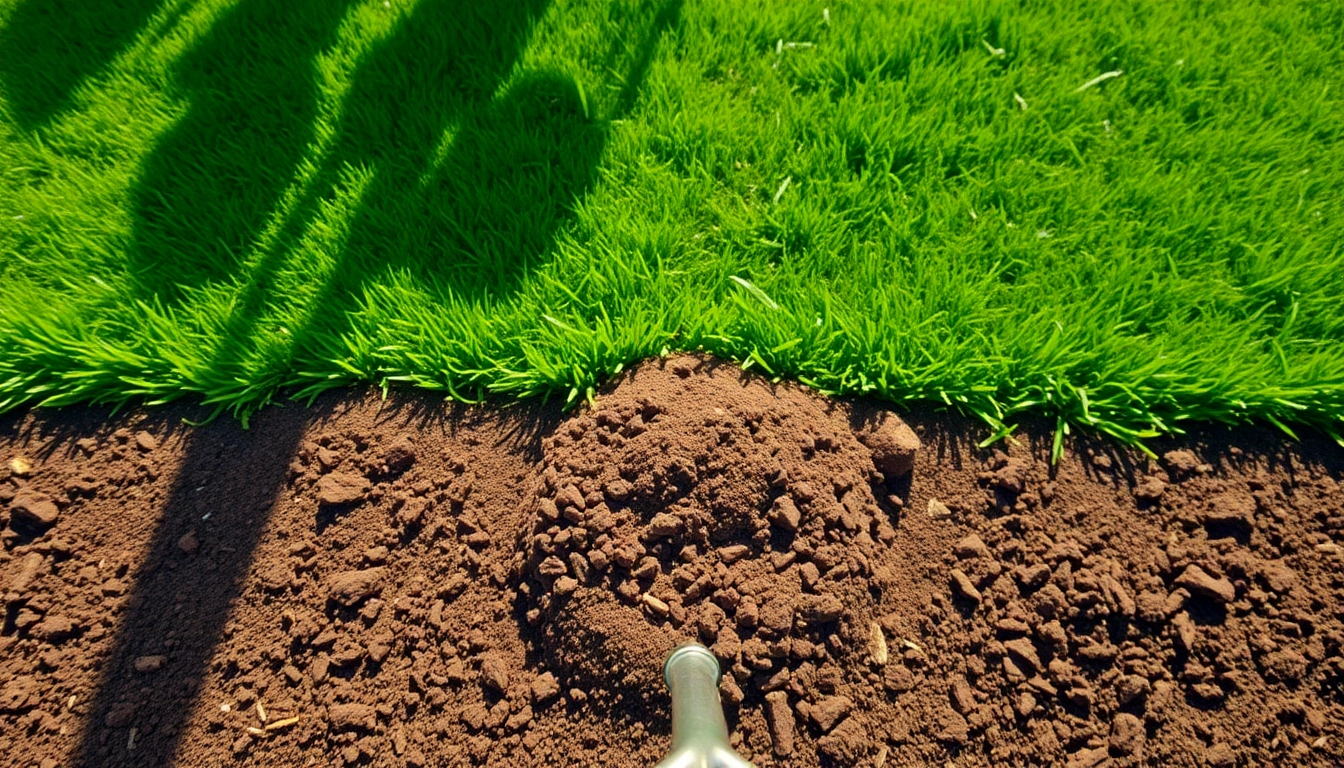Understanding Lawn Top Dressing
What is Lawn Top Dressing?
Lawn top dressing is an essential gardening technique involving the application of a thin layer of soil or compost on the grass surface. This process serves multiple purposes, such as enhancing soil health, improving drainage, and providing nutrients to promote lush grass growth. The materials used are typically high in organic matter, which aids in enriching the existing soil without suffocating the grass underneath. Specifically, top dressing can include a mix of compost, soil, and sand, helping to create a balanced environment ideal for grass health and longevity.
Benefits of Top Dressing Your Lawn
Top dressing your lawn comes with numerous benefits that can help maintain its vitality and ensure a beautiful outdoor space. The primary advantages include:
- Improved Soil Structure: Top dressing enhances the soil’s layer, promoting better aeration, drainage, and root development.
- Increased Nutrient Availability: Adding organic materials like compost replenishes essential nutrients that may be lacking in the soil.
- Enhanced Microbial Activity: Compost stimulates the activity of beneficial microorganisms that maintain a healthy ecosystem within the soil.
- Surface Leveling: This technique can help smooth out uneven areas of the lawn, creating a more visually appealing landscape.
- Weed Suppression: A layer of top dressing can help deter weed growth by covering seed beds and preventing their germination.
When to Consider Lawn Top Dressing?
Timing is everything when it comes to top dressing a lawn. Although it is suitable at various times throughout the year, the best time to undertake this task is just before the growing season, typically in early spring. This ensures that the lawn can recover from any stress caused by the application.
It’s also important to consider top dressing following aeration or overseeding, as this provides a nutrient-rich environment for new grass seedlings. Additionally, consider addressing areas of wear and tear, unevenness, or after soil depletion due to drought or pest issues.
Necessary Materials for Effective Top Dressing
Choosing the Right Compost and Soil Mix
The success of top dressing largely depends on the materials chosen. A high-quality compost or soil mix will significantly influence the outcomes. For optimal results, select a mix that contains:
- Good Quality Compost: Choose well-decomposed compost that is free from contaminants and pathogens.
- Topsoil: Use weed-free sandy loam soil to maintain a balanced mixture.
- Sharp Sand: This promotes aeration and improves drainage in clay-heavy soils.
A recommended ratio for a top dressing mix is three parts sharp sand, six parts sandy loam topsoil, and one part compost.
Tools and Equipment for Lawn Top Dressing
To effectively apply top dressing, you’ll need a few essential tools:
- Drop Spreader: Ideal for uniform distribution of the top dressing material.
- Rake: A garden rake is helpful for leveling the top dressing material.
- Wheelbarrow: Convenient for transporting mixed materials to the site of application.
- Shovel: Essential for moving compost and soil.
Cost Considerations for Lawn Top Dressing Supplies
The cost of top dressing your lawn can vary significantly depending on the materials you choose and the size of the area to cover. Generally, you can expect to spend approximately $1 to $2 per square foot when hiring professional services, while DIY costs greatly depend on the materials purchased. A bulk load of compost or soil can range from $30 to $100. Ultimately, investing in high-quality materials can lead to better lawn health and longevity.
Step-by-Step Lawn Top Dressing Process
Preparing Your Lawn for Top Dressing
Proper preparation is crucial for effective top dressing. Here’s how you can prepare your lawn:
- Mow the Lawn: Begin with mowing the grass to a lower height to ensure the top dressing integrates well with the existing turf. Aim for a mowing height of about 1 to 2 inches.
- Water Thoroughly: Water the lawn a day before the top dressing application to ensure the grass is hydrated but not soggy.
- Eliminate Debris: Remove any leaves, sticks, or other organic matter from the lawn to create a clean surface for the top dressing.
Application Techniques for Uniform Distribution
Distributing top dressing evenly is essential for its effectiveness. Here are the steps to follow:
- Mix Materials: Combine your compost and soil according to the recommended ratios.
- Use a Drop Spreader: Fill the spreader and set it to the desired depth (typically 1/4 inch). Walk evenly across the lawn, overlapping slightly with each pass for uniform coverage.
- Level with a Rake: Use a rake to spread the mixture evenly, filling in any low spots. Ensure that the grass blades are still visible after the application.
Post-Application Lawn Care Practices
After applying the top dressing, it’s vital to maintain proper lawn care practices to support recovery and growth:
- Water Regularly: Keep the lawn adequately watered for the next couple of weeks to facilitate the integration of the top dressing into the soil.
- Avoid Heavy Traffic: Minimize foot traffic on the lawn for at least two weeks to allow the grass to recover.
- Monitor for Growth: Observe how your grass responds in the following weeks and adjust your watering and care routine accordingly.
Common Mistakes to Avoid in Lawn Top Dressing
Overdoing Your Lawn Top Dressing
One of the most common errors homeowners make is applying too thick a layer of top dressing. It is essential to apply only a thin layer—generally no more than 1/4 inch—so that the grass can effectively grow through. Excessive top dressing can suffocate the grass, prevent sunlight from reaching it, and create more drainage problems than it solves.
Using Poor-Quality Materials
Choosing inferior compost or soil can negatively affect your lawn’s health. Ensure that you opt for high-quality materials that are well-decomposed and free from weeds, pests, or other contaminants. Poor-quality top dressing will not provide the nutrients necessary and can lead to further issues.
Ignoring Grass Type and Growth Conditions
Different grass types have varying requirements, and top dressing should reflect the conditions and characteristics of your lawn. For instance, certain grasses thrive in cool climates while others do better in warmer areas. Knowing your grass type helps to dictate the timing and materials that will be most beneficial for your lawn.
Maximizing Results from Lawn Top Dressing
Integrating Top Dressing with Other Lawn Care Techniques
Top dressing should not be a standalone practice; integrating it with other lawn care techniques enhances your efforts. Consider pairing it with:
- Aeration: Aerating your lawn before top dressing allows for better penetration of nutrients and helps break up compacted soil.
- Overseeding: Top dress after overseeding to provide a nutrient-rich environment for the new grass seeds to establish themselves.
Monitoring Lawn Health Post Top Dressing
After completing the top dressing application, keep an eye on your lawn’s progress. Monitor for signs of growth, areas that may need additional care, and any pests that may emerge. Regular evaluations will inform your ongoing care strategies and help you diagnose any problems that arise.
When to Repeat Lawn Top Dressing
Many lawn care experts recommend top dressing once or twice a year, depending on the condition of your lawn. Observing growth patterns and signs of nutrient depletion can indicate when your lawn might benefit from another application. Keep in mind the seasons—spring is typically the best time for revitalization and nutrient boosts.
In conclusion, lawn top dressing is a valuable practice for enhancing the health and appearance of your lawn. With the right materials, techniques, and timing, you can transform your yard into a vibrant, green oasis that thrives throughout the seasons.



